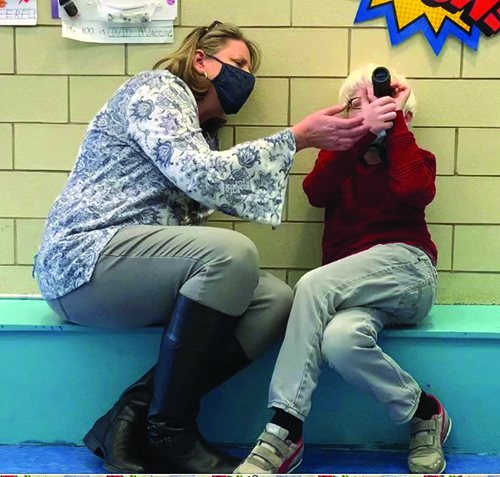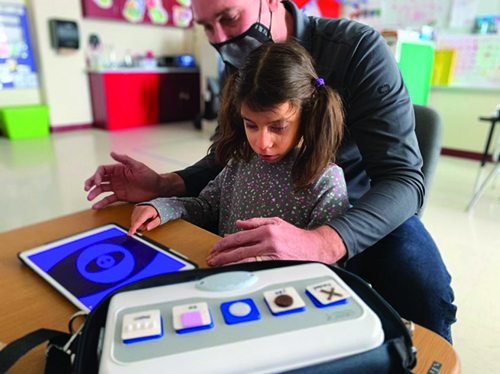Teaching math content without manipulatives is almost impossible.…It isn’t as much about what the school has done but we need prep time to prepare materials if we are virtual. You can’t tell me on Thursday at 5 PM we are [going to be] virtual on Friday morning. I was in 14-day quarantine without access to any of my teaching materials because I couldn’t go into my classroom. I figured it out with a friend slipping in to grab some things for me and slipping out but otherwise, I’d be out of luck. There was no chance to get students the materials they needed. We have to have a prep day. —TVI
Students cannot be expected to participate in education if they do not have compen- satory tools that allow them to access the curriculum. Family members were asked what tools their child was currently using at home for education and what tools their child did not have at home that are impacting their current learning. These data are reported for preschool and school-age students in Table 13. It is positive to note that half of the family members did not indicate that there were any tools their child did not have access to for learning. The (n) for each column represents the number of family members who provided data for the question.
Table 13: Tools Available and Not Available to Students at Home
| Blind and Low Vision Students | Students with Additional Disabilities | |||
|---|---|---|---|---|
| Compensatory Tools | Tools Available at Home (n=71) | Tools Not Available at Home (n=38) | Tools Available At Home (n=87) | Tools Not Available at Home (n=43) |
| Tablet | 48 | 7 | 64 | 5 |
| Laptop | 54 | 5 | 60 | 5 |
| Smartphone | 34 | 5 | 34 | 8 |
| Handheld magnifier | 13 | 5 | 20 | 8 |
| Handheld Monocular telescope | 9 | 4 | 8 | 8 |
| Electronic Magnifier/CCTV | 9 | 11 | 15 | 11 |
| Large Print Books | 9 | 14 | 25 | 7 |
| Cane/long cane/white cane | 49 | 2 | 39 | 4 |
| Pre-cane/Adaptive Mobility Device (AMD) | 1 | 2 | 3 | 7 |
| Perkins braillewriter | 37 | 5 | 28 | 8 |
| Refreshable braille display | 19 | 9 | 10 | 12 |
| Braille recreational books | 34 | 9 | 23 | 13 |
| Victor Reader Stream or device to listen to audiobooks | 13 | 4 | 18 | 8 |
| Abacus | 18 | 3 | 16 | 9 |
| Tactile graphics materials | 23 | 8 | 18 | 17 |
| Specialized/alternative communication device or system | 2 | 7 | 9 | 17 |
| Adapted books | 9 | 6 | 18 | 11 |
My biggest frustration is overall accessibility. Example, the class is assigned an online science simulation on creating circuits that is produced by a curriculum company. The science simulation is visual with no auditory information and the only way to connect the pieces is by using finger gestures. My child can’t see the parts so can’t do the assignment. The common answer for this situation is to exempt my child because it is too visual. Why? Doesn’t my child need to learn and understand this concept of "currents" just like everyone else? Why does my child not have the opportunity to learn ideas and concepts because companies don’t make things accessible, schools buy those inaccessible programs and then don’t provide an alternative way to learn the same information? I wonder if this was happening all the time when face-to-face instruction was provided and I didn’t know it and now in remote [instruction] I see the lack of accessibility OR when schools were in person they had all the supplies or extra help to make assignments accessible and now because of remote learning the school doesn’t have a method to make the materials in an accessible way. —White female family member of a child with low vision, 16 to 18 years old, and a dually certified professional
A key question for the researchers was to understand what digital learning tools students were being asked to use and if these tools were accessible to students with visual impairments. In the survey, professionals were asked about which digital learning tools their students were expected to use by their general or special education teachers regardless of accessibility for their students. They were then asked which of the learning tools were not accessible to students because of students’ visual impairments. We cannot know if the students the professionals currently serve had actually used the digital learning tools, nor if their judgment on accessibility was based on firsthand knowledge. Yet, the data reported in Table 14 does raise concerns about the accessibility of digital learning tools commonly used in education. Table 14 includes digital learning tools that students are expected to use as reported by 25 or more vision professionals.
Table 14: Percentage of Digital Learning Tools Reported by Professionals to Not Be Accessible to Students with Visual Impairments
| Tools expected to be used (n) | Tools that are not accessible (n) | Percentage of professionals who reported that tool is not accessible | |
|---|---|---|---|
| Class Dojo | 90 | 22 | 24 |
| Edgeunity | 36 | 17 | 47 |
| Edpuzzle | 48 | 25 | 52 |
| FaceTime | 52 | 10 | 19 |
| Google Classroom | 301 | 46 | 15 |
| Google Drive | 258 | 33 | 13 |
| Google Hangout | 44 | 11 | 25 |
| Google Meet | 230 | 25 | 11 |
| i-Ready | 67 | 45 | 67 |
| IXL | 77 | 44 | 57 |
| Kahoot! | 136 | 66 | 48 |
| Microsoft Teams | 89 | 15 | 17 |
| Nearpod | 71 | 35 | 49 |
| Quizizz | 36 | 27 | 75 |
| Quizlet | 29 | 40 | 40 |
| Remind | 78 | 7 | 9 |
| Schoology | 97 | 30 | 31 |
| Seesaw | 137 | 47 | 34 |
| Zoom | 326 | 45 | 14 |
The digital learning tools reported used most frequently were Google Classroom, Google Drive, Google Meet, and Zoom. These digital learning tools were discussed extensively by family members and vision professionals in responses to open-ended questions. The researchers were not surprised by how many less frequently used digital learning tools were reported to not be accessible, but even frequently used tools were reported to have accessibility issues. From these limited data, it is clear additional research is needed to understand the impact of digital learning tools on the education of students with visual impairments.


